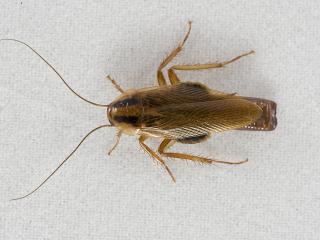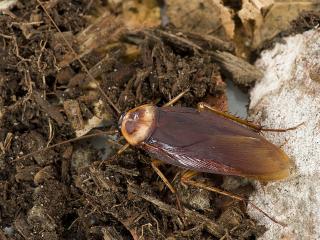Types of pest cockroaches
German cockroach
The body of an adult German cockroach is about 12mm long. It is beige to light brown in colour, with two dark stripes on the back of its head. It is the most widespread and successful cockroach and is commonly found in homes, restaurants, food processing plants, supermarkets and warehouses.
The German cockroach seeks warm moist conditions with access to food and water. They are common in domestic kitchens and commercial food-handling areas and are active at night, hiding during the day in dark, secure places. They seek out moist areas near sinks, dishwashers, cracks and crevices in the pantry, kitchen and bathroom cupboards, under electrical, heating and cooking appliances and inside wall cavities or behind skirting boards for their homes. They can often be seen on the undersides of drawers or benchtops.
Although adults are winged, this cockroach rarely flies. Dispersal is mainly through individuals or egg cases attached to food containers, cartons, fridges, stoves and other appliances or materials brought into a building.
German cockroaches do not thrive in locations away from humans or human activity. The German cockroach is the most prolific breeder of cockroach species. The female lives up to six months and carries an egg capsule containing 30 to 40 eggs. Development from egg to adult can occur in 45 days, during which the nymphs moult six times.
Because of the rapid breeding, a small initial infestation can become a major problem within a few months.
American cockroach
The American cockroach is the largest of the cockroach pest species. Its adult body is 30 to 50mm in length and is reddish brown with a yellowish band behind the head. It lives in warm, moist, dark conditions – indoors in colder regions, but mainly outdoors in warmer regions. Its preferred daytime habitats are the warm, dark, moist locations associated with sewers, and wall, roof and subfloor voids. They often congregate around hot water pipes, fridge motors, boilers and other heating appliances.
The American cockroach prefers decaying, organic matter, but will feed on a wide variety of plant and animal material. They fly readily and are attracted to lights, especially on warm summer nights. They can often be seen around stormwater drains during summer.
The female life span is up to two years. Even though the incubation period of eggs is five to eight weeks, under ideal conditions they quickly reach plague proportions. An adult without food or a water source may survive for about two to three months.
Native Australian black cockroach
The native Australian black cockroach is commonly found indoors during the summer months. It is black with a white margin and grows to 35mm in length and is wingless, even in the adult stage.
This cockroach is primarily an outside species which feeds on decaying plant material. It is not a recognised carrier of disease because of its preference for leaf litter over human refuse. In summer it comes inside to shelter from the heat.
Brown banded cockroach
The relatively small, brown banded cockroach is pale brown with very pale bands across the thorax and abdomen. Unlike the other pest species it can live in dry situations and may be active throughout the building, rather than being restricted to the kitchen and other damp areas. They are particularly suited to our modern technology and are often found in electrical equipment such as computers, keyboards, microwave ovens, wardrobes, dressers, cabinets and behind bookshelves. Their wide dispersal within premises can make control difficult.
Its egg cases are glued to surfaces and the hatched nymphs require two to four months to develop into adults. Adults can live for up to six months.
The brown banded cockroach may fly if disturbed and it is not unusual for it to be observed during daytime.


